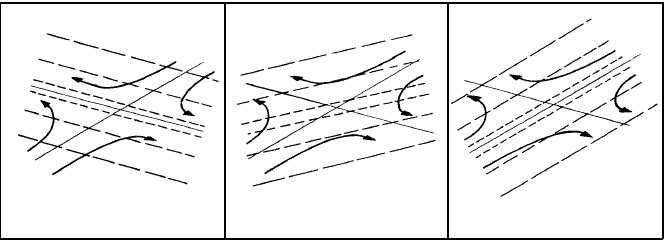temperatures and warm tropical air moves northward
toward colder temperatures.
The wind flow has formed a deformation field. A
deformation field consists basically of an area of flat
pressure between two opposing highs and two opposing
lows (also called a COL or saddle). It has two axes that
have their origin at a neutral point in the COL (view A
in fig. 4-23). The y axis, or axis of contraction, lies
between the high and low that bring the air particles
toward the neutral point. (Note the flow arrows in fig.
4-23.) The x axis lies between the high and low that take
air particles away from the neutral point and is known
as the axis of dilation.
The distribution and concentration of isotherms T1
through T6 in this deformation field determine whether
frontogenesis results. If the isotherms form a large
angle with the axis of contraction, frontogenesis
results. If a small angle exists, frontolysis (the
dissipation of a front) results. It has been shown that in a
perpendicular deformation field, isotherms must form
an angle of 450 or less with the axis of dilation for
frontogenesis to occur as shown in views A and B of the
figure. In a deformation field not perpendicular, the
critical angle changes correspondingly as illustrated in
views A and B of figure 4-24. In most cases,
frontogenesis occurs along the axis of dilation.
Frontogenesis occurs where there is a concentration of
isotherms
with
the
circulation
to
sustain
that
concentration.
CONDITIONS NECESSARY FOR
FRONTOLYSIS
Frontolysis, or the dissipation of a front, occurs
when either the temperature difference between the two
air masses disappears or the wind carries the air
particles of the air mass away from each other.
Frontolytical processes are more common in the
atmosphere than are frontogenetical processes. This
comes about because there is no known property of the
air, which is conservative with respect to all the
physical or dynamical processes of the atmosphere.
Frontolytical processes are most effective in the
lower layers of the atmosphere since surface heating
and turbulent mixing are the most intense of the
nonconservative influences on temperature.
For frontolysis to occur, only one of the two
conditions stated above need be met. The simultaneous
happening of both conditions results in more rapid
frontolysis than if only one factor were operative. The
shape and curvature of the isobars also give valuable
indications of frontolysis and frontogenesis, and,
therefore, possible cyclolysis or cyclogenesis.
On a cold front, anticyclonically curved isobars
behind the front indicate that the FRONT is slow
moving and therefore exposed to frontogenesis.
Cyclonically curved isobars in the cold air behind
the cold front indicate that the front is fast moving and
exposed to frontolysis. On the warm fronts the converse
is true.
Anticyclonically curved isobars in advance of the
warm front indicate the front is fast moving and
exposed to frontolysis.
With cyclonically curved isobars the warm front is
retarded and exposed to frontogenesis.
WORLD FRONTOGENETICAL ZONES
Certain regions of the world exhibit a high
frequency
of
frontogenesis.
These
regions
are
4-25
T1
T2
T3
T4
T5
H
L
X
X
Y
T6
T1
T2
T3
T4
T5
T6
H
L
Y
T1
T2
T3
T4T5
T6
H
L
A.
FRONTOGENETIC
B.
CRITICALLY
FRONTOGENETIC
C.
IDEALLY FRONTOLYTIC
AG5f0424
Y
H
H
Y
X
X
Y
Y
H
X
X
L
L
L
Figure 4-24.—Nonperpendicular deformation field.

